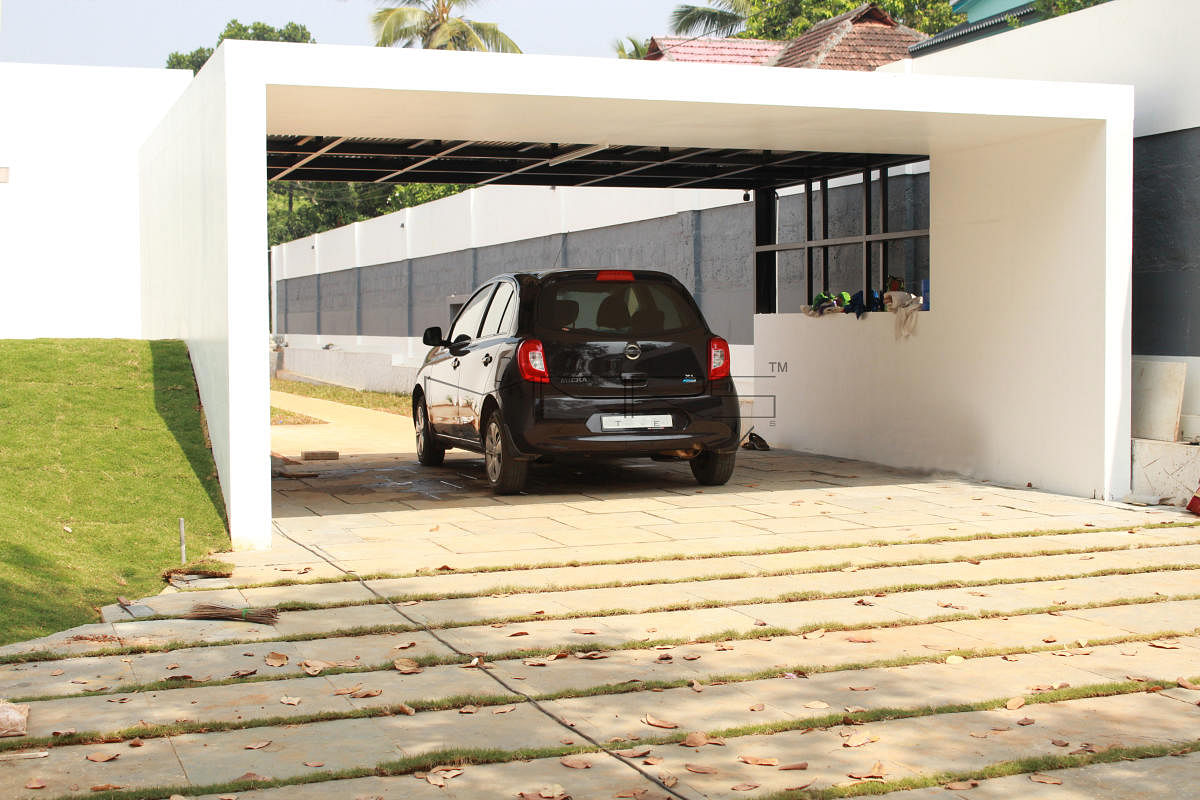

Boxy garages are making way for stylish, multi-use car parking spaces. A growing fascination amongst the young to display gorgeous cars is driving the demand. Several factors go into determining the aesthetics of parking spaces, say architects.
Keep it flexible
The first step is to create a design that doesn’t feel like a parking space when the car is out, says architect Pramod Jaiswal of BetweenSpaces, Bengaluru. In Bengaluru, where plots are small and homes open into busy roads, you can create a basketball court-cum-parking area in the basement, where kids can play when the car is not inside, he says.
In one of his ongoing projects (a textile design studio) on Dr M S Ramaiah Road, Bengaluru, Pramod is working on an open-to-sky sitout-cum-parking area. To blend it with the landscape and prevent skidding, he has opted for concrete flooring (with patterned and exposed stone chips).
Sandeep Umapathy, an associate architect with Mistry Architects, demonstrated the versatile use of an entrance porch in a Bengaluru residential project: the space is semi-covered using Mangaluru roof tiles with glass inserts to let in natural light and breeze. The car park also serves as an extended deck for small gatherings.
Multi-purposing is key in city-context parking designs to save land area. While setting up a car park, minimise hardscaping, and add green spaces to allow water percolation, Sandeep says. Pramod worked with a similar design at the Cuckoo’s Nest, a Bengaluru home. Here, the extended entry canopy was articulated with intricate wire cut-brick jaali walls, a form-finished concrete slab roof, and granite flooring, allowing flexible use.
Artistic touch
Happy colours brighten up parking areas so add colourful beams and complement them with lights, says Goa-based architect, Rahul Deshpande. He explored this in a multi-level parking at the entrance of Panaji, Goa. When the building is lit up, the colours splash beautifully, particularly at night, he notes.
You can opt for soft, indirect lighting, or sensor lights. To dial down the boxiness, you can choose a curvilinear facade, he adds.
Architect Chetan Shivaprasad of Bengaluru-based Kham Design opted for a curvilinear jaali porch roof, concrete tiles with anti-skid buttons, concrete slabs, and steel girders painted in white to create his parking-cum-deck design for another Bengaluru home. Naresh Medappa of Mindspace Architects, Bengaluru, says, for a visual appeal, you can add murals or doodles.
Have view in mind
The Anvar Residence, a project by Kochi-based Silpi Architects, came with a challenge: the plot was small, and the only option was to create a parking area in front of one of the rooms.
However, Sebastian Jose, principal architect with the firm, didn’t want to hamper the view from the room. So he detached the parking and placed it towards the entrance and then added a slanting wall, to link it with the house, creating a unique facade.
He added green spaces in between, so the room opens into them. Stairs from the car porch lead to a deck above, where the family could spend their evenings. The landscaping extends into the car porch. So when the space is empty, it can be used to host small parties.
Ajay Abey, managing director of CSBNE, Kollam, crafted a semi-basement parking space using exposed laterite walls and mud concrete floor, for a Kochi home. To save space and avoid visual blockage this method is useful, he says. “The stilt floor design helped to achieve a height of 2.4m, which was adequate to park a car. The space also features our signature roof slab,” he adds.
For a traditional-style home, it’s best to hide your parking space. Subhash Saraff, principal architect with A360 Architects, Bengaluru explored this solution in a Tamil Nadu-residential project, where he created subterranean parking, hidden using landscaping.
“We excavated under the soil and added a retaining wall. When you have many cars, and a hilly terrain, this works well,” he adds.
Interesting ideas
“Don’t create a car park that disturbs your mind,” says Mahendra Mohan, managing director of MARS Architects, Bengaluru.
In a tropical context, sandwich sheets (a roof cladding with noise-absorbing properties) comes in handy to prevent the noise from rain. “We used them for a steel-concrete contemporary-style car park at a Palakkad villa,” he shares.
Sebastian also worked with a tropical modern context for a Kerala home. The house had pitched roofs, so for the car park, a flat slab roof with skylights (complemented with roof-top greenery) was used. “Natural stone flooring and brick-clad walls add to the look. The aesthetics of the space works well to display cars and host parties when the cars are out,” he says.
Wallet factor
To plan an open or semi-covered car park (for one car), set aside 2.7 x 5.5 meters. If you have walls, then opt for a 3 x 6 meter space.
Depending on the design, the cost would range from Rs 2 to 4 lakh.
Design challenges
*Preventing visual blockage of the rooms
*Working out a layout that takes minimum circulation space for the cars
Maintenance
*Use washable paint, wall claddings, or wall tiles
*Riverbed finish stones are easy to clean in case of grease spillage
*Ensure proper exhaust for smoke